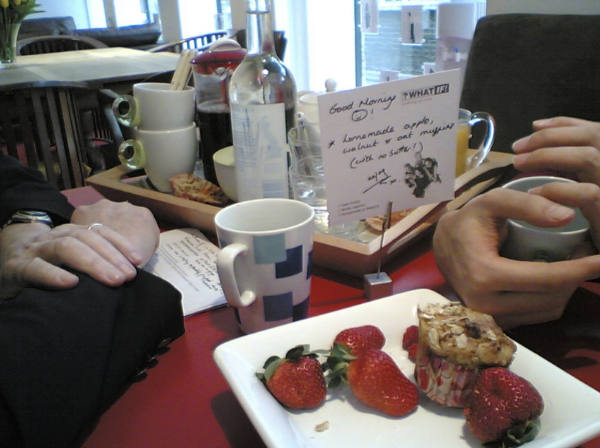First impressions count, right? Everyone knows that. It’s almost a cliché. There are various stats out there saying that judgements are formed in a matter of seconds – seven to be precise. Whether it’s a new client visiting your offices for the first time or a high calibre candidate arriving for a job interview, you’ll want to make sure they see the best your company can offer.
So why is it that, time and again, I visit offices and discover some real horror stories? Disinterested receptionists, scruffy furniture, foul coffee… and that’s if I can find the offices in the first place. This stuff is important because it says all that needs to be said about your business. If you’re truly looking to grow your company, you’ll need to invest time and energy into getting these details right. Because if you don’t care about first impressions, your visitors will think that you don’t care about anything.
Make sure people can find you
Bad first impressions can be made as soon as people visit your website and can’t find even the most basic of information. Directions, postcode and a phone number – it’s not a lot to ask! But sometimes designers get so carried away, building aesthetically beautiful websites that bury essential information. As you search through complicated page structures, you’re left thinking, ‘Well, they obviously don’t want to talk to me!’
Phone numbers should be visible on every page of your site and directions should be clear and easy to follow. And please make sure that your postcode works in Sat Navs and Google maps. I went to see a new client recently and the address given on Google took me to his old office and not his new one. I ended up 20 minutes late for the meeting. Very frustrating!
Ditch the automated messages

How many times have you been kept in a queue, drumming your fingers and listening to ‘Greensleeves’ on repeat? God – I hate automated phone systems! As a business coach, I see the things that small businesses do thinking it makes them look bigger (but actually makes them look sh*tter). This is one of them. Just because you’ve installed a cloud-based PABX and it offers automated answering doesn’t mean you should turn it on!
How different it is to have your call answered in 3 or 4 rings by a human being. Even better if that human being is qualified to answer your query without having to take your details and get someone else to phone back. When I took over customer experience at Peer 1, our telephone answering was automated. It took six months of battles but, eventually, I got rid of it. Staff told me it was going to cause them more work. I said they needed to shift their mindset to the awful experience our customers were getting. Hold times and abandonment rates were sky high. Sometimes customers were queuing for 3 minutes or more. It had to stop!
In our daily huddles, I told the shift managers they needed to ring every person who’d hung up in frustration the previous day and apologise that they hadn’t got through. You can imagine how that went down! We got rid of triaging and within three months, the on-hold time dropped from an average of 2.5 minutes to 17 seconds. Our goal was to answer every call within three rings and have zero abandonments. It’s amazing what you can achieve with daily focus.
Another pet peeve of mine is automated responses. Often, I’ll find companies have an SLA around response times to tech support tickets, so they automate them. This does nothing for the customer – it’s just not what people want. Automating a message to say you’ve received their query and will get back to them doesn’t mean that they are any further forward. And it’s even worse if you don’t get back to them within the timeframe you’ve promised.
It’s like those messages you get from distribution companies to say they’ve tried to deliver your parcel, but no-one was home. Often this is a lie. I’ve been working with a clear view of my driveway all day with not a van in sight. So, they’ve sent me an automated lie. Great! Then I go to their website and end up communicating with a chatbot. If I ask to talk to a human being, I’m told the system won’t allow it. Call that customer service DPD?
Ensure every call is answered by a helpful human
It’s so infuriating when you eventually speak to someone, only to find that they don’t know who you are and can’t help you. Companies often treat service as a cost and calls are answered by low-paid employees.
This is one of the many things we did differently at Rackspace. Our purpose was Fanatical Support® and one of the ways we committed to this was ensuring all customer service calls were answered by Level 3 engineers. They knew how to fix your problem and, better still, they loved doing it. And they weren’t working to the SLA, providing only acceptable levels of service.
There are times when I’m talking to someone on the phone and I can tell they don’t want to help. They really should get another job! Customer service isn’t in their DNA. I remember a while back, when I was working at Pipex, a distraught customer called me on a Saturday. She’d been through a huge ordeal, caring for her dying father who’d been diagnosed with lung cancer. During this time, we hadn’t been able to reach her as her server had been hacked and she didn’t have a separate email address. Now our solicitors were after her for an unpaid debt of £1,000.
I spent half an hour reassuring her and told her that I’d write off the debt. In the office the following Monday, I spoke to our Customer Service Manager to arrange this. Do you know what she said? ‘How do you know that story’s true – did her father really die?’ I was staggered. I suspected that attitude had served her well in the past but it didn’t work for me.
In contrast, I had a fantastic experience when I visited the offices of WebMart recently. Simon’s PA, Lisa, rang me the day before, making sure I had the right directions and asking me for my hot beverage of choice, so they could get it ready for my arrival. She told me where I should park and to follow the red carpet up to the door – talk about celebrity treatment! I was then met by a charming young lady whose enthusiasm for the company was infectious. She gave me a tour of the building and, by the time I arrived at the meeting, I could tell I was in a purpose-driven business with engaged, happy staff.
Invest in your Reception area

Sounds obvious but your Reception area is where first impressions are formed. As the story I’ve just described at WebMart shows, you can pick up the buzz of a place just from the welcome you receive when you walk through the door. It’s like entering a hive. In successful companies, someone will come and ask you quickly are you ok, offer you a hot drink and deal with you efficiently and quickly. There are places I’ve been (particularly in London where Reception is outsourced) where no-one makes eye contact as you check-in and you’re abandoned to sit on shabby furniture, leafing through coffee-stained magazines.
Your Reception area needs to reflect your business. It’s a golden opportunity to impress and you can communicate so many messages through it. My favourite is to instal a brag wall. Just the logos of the customers you do or have done work for. This allows visiting customers and prospects to immediately know they’re in the right place. At Peer 1, we went further, creating different zones and training our new staff in the stories to tell when showing people around.
This almost resembled the stations of the cross (my Catholic heritage coming through again!) In addition to our brag wall there was our Values wall, complete with shout-outs on post-it notes to members of staff who’d embodied these values. Around the corner was our network operating centre – an impressive array of big screens showing our global data flow and alarms. Then a world map with postcards from various members of staff pinned to the relevant country they’d visited. The new starters wall had mug shots of our new recruits along with ‘10 things you don’t know about me’ and there were further smiley photos of our Employee of the Month. All of these areas told a positive story. When our visitors arrived in their meeting rooms, they’d already had the corporate presentation. We didn’t need to say much more about the sort of company we were.
Serve decent coffee

What more is there to say about this? There is absolutely no excuse for serving instant coffee. Ever. Gold Blend isn’t a thing any more. You may view decent coffee as an additional expense, but you’ll lose so much more by coming across as a cheapskate organisation that doesn’t value its customers or its staff.
At Rackspace, our coffee machines were leased from Starbucks but the world of coffee has come a long way since then. Pact or artisan coffees are widely available and decent machines are affordable for every workplace.
Tidy up your offices
Look around you. Are your offices clean and tidy? Does equipment work and any broken stuff go in the bin? When I first visited Pipex, the Customer Service Director took me to their call centre. As I walked in, I noticed three copies of the phone book lying on the floor, covered in dust. I turned to him and said, ‘Let me show you around’. He looked puzzled. What did I mean? I pointed to the dirty directories and said, ‘How long have those been there. Months? Years? For all that time, you’ve walked past them and ignored them, so your staff have done the same. I’ve seen all I need to see!’ The senior leadership team casts a long shadow in a business. You have to lead by example.
When I arrived at Peer 1 in Atlanta, there was obviously no sense of pride. I discovered a knackered old sideboard that looked like it had never been opened. Inside it was a broken coffee machines and computers. Straight in the skip! Old chairs were thrown out. Walls were repainted. Carpet renewed.
Up until that point, none of the staff had felt empowered to sort this out. I wanted to change that. How could I expect them to care about the customer experience if they didn’t care about their own surroundings? By improving our environment, we raised the bar. I wanted them to feel, from the moment they walked in, that we had high expectations of them. And I did this by providing a workplace that they were proud of.
Be punctual![]()
Ah yes – being on time for meetings. I’ve turned up five minutes early to be polite but the person I’ve come to see keeps me waiting for a quarter of an hour – that’s impolite! Are they disorganised? Or is it some kind of power thing – maybe they think they’re more important than me. Either way, it creates a dreadful impression. Please don’t make me watch Sky News whilst I wait for you in Reception. It will make me want to kill myself! If you do keep me waiting, give me easy access to fast wifi.
Get rid of reserved directors’ parking
Designating the best parking spaces for directors is such a bad idea – on so many levels. It sends out a hierarchical, old fashioned message that is pretty negative. These parking spaces should be reserved for your visitors – whether they are clients or new recruits. Or how about allocating a space to your Employee of the Month (as we did at Peer 1)? Now that’s instantly a more positive message to send out to the world. Before people step through your front door, they will know how much you value your staff.
Make an effort and show you care

It’s amazing the difference you can make by making a bit of an effort for a visitor. Great coffee is a must but after I’d experienced a welcome tray at ?WhatIf! we started serving homemade cake. This arrived every time a client came to us for a meeting. It created a sense of theatre around the sales process. It instantly said, ‘We’ve made an effort’ and gave prospective clients a sense of the service they could expect.
The cake was a big part of this. Huge and chocolate. They had to be homemade (often by a member of staff’s mum). A bought cake wouldn’t have cut it. Our quote conversion rate rose from 40% when we visited clients to 80% when they came to us and were given Sam’s mum’s cake!
And finally… a word about toilets
Your washroom facilities are a window into your company’s soul. If you couldn’t eat off the floor of the toilets in a restaurant, then you need to worry about their kitchen cleanliness. Again, it comes back to making an effort and attention to detail. The only hand-dryers that work are Dyson Airblades so make sure you have them. If your Finance Director tells you they’re too expensive, argue that you’re changing the mindset of your business to drive towards excellence in everything that you do.
At Peer 1, our loo was twinned with another in Africa – a really worthwhile project that had been the suggestion of an employee. Another positive message. Even your toilets can tell a story.
I recently went to see a potential new client and knew, as soon as I walked through the door, that I wasn’t a good fit for their business. The doormat was worn, the stairwell smelled like a public toilet and his Receptionist ignored me when I arrived. This client was in love with the idea of coaching but I could tell he didn’t want to make the effort needed to succeed.
Open your eyes, look around your offices and imagine what you’d think if you’d arrived for the first time. Then make change a priority. Scaling up requires obsessive attention to detail and a real drive to success.

